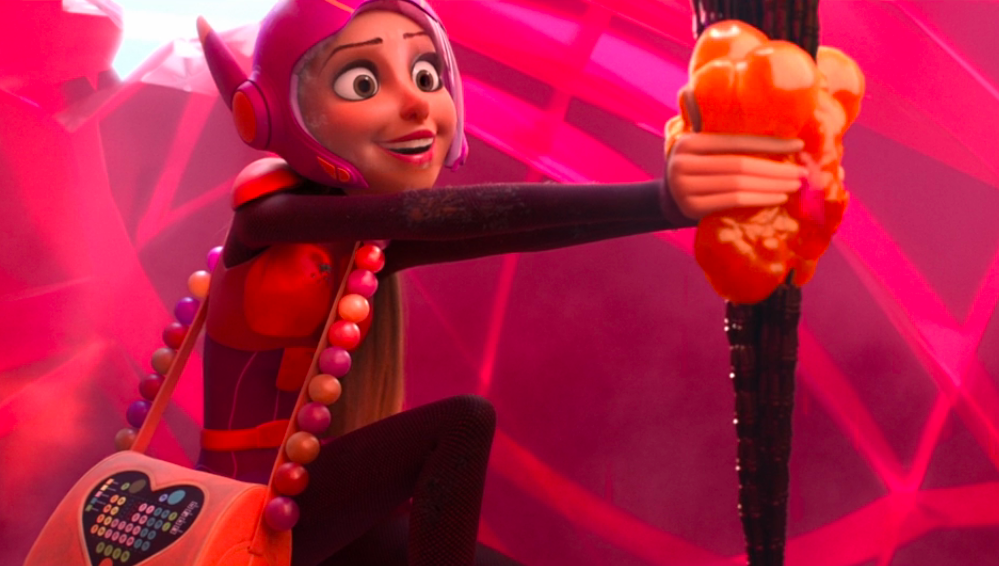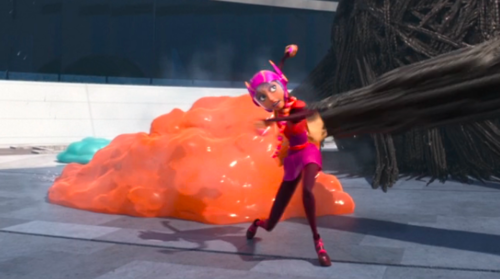Honey Lemon and the real-life chemistry of Big Hero 6
Guest post by Sarah Anderson
Big Hero 6 follows a group of (you guessed it) 6 friends-turned-superheroes on a mission to save the world. While most of the heroes display classic super powers—flying, breathing fire, super speed—one member’s power is her knowledge of science.
Chemistry whiz Honey Lemon uses her magical periodic table purse to make colorful spheres of different chemical compounds. She then launches these spheres to activate various effects that help the team defeat the villain.
But is the chemistry shown in the movie accurate? Which compounds might Honey Lemon be using given the properties of the spheres?
Bouncy Blob
During the first confrontation with “the man in the mask” (later revealed to be Professor Callaghan), Honey Lemon uses a sphere to create a bouncy blob that she jumps onto from a high perch.
This compound was likely a polymer, which is a long chain of molecules strung together like beads on a necklace. And just like a necklace, the bulkier the units of a polymer are, the less flexible the chain is.
In polymers made up of small molecules, the bonds between the molecules can rotate freely, giving them an elastic quality. Common “elastomers” include cis-polyisoprene and polydimethylsiloxane, and Honey Lemon probably used one of them to absorb the impact from her fall.
Icy Surface
In this same scene, Honey Lemon makes a compound to create an icy surface for Professor Callaghan to slip on (but unfortunately her teammate Go Go slips on it instead).
Water doesn’t freeze until it reaches 32 degrees Fahrenheit. We can assume that the climate in San Fransokyo is a hybrid of that of San Francisco and Tokyo, and it rarely falls below this temperature in either of these places. Therefore, the warehouse isn’t that cold, and this compound can’t be water.
It is likely acetic acid, which has a freezing point of 62 degrees Fahrenheit and could reasonably form ice in this environment. Acetic acid is also what gives vinegar its distinct smell, so hopefully Go Go washed her suit afterward.
Expanding, Solidifying Foam
While practicing her skills, Honey Lemon creates a compound that rapidly grows and solidifies when she throws it at the butler’s feet, trapping him in place. This compound is likely similar to the quick-hardening spray foam that is used to insulate buildings.
The foam forms when two types of organic molecules, one called an isocyanate and the other a polyol, are mixed together. When these molecules react, they join up in a chain-like structure to form another polymer.
But this polymer undergoes something called cross-linking, which is when different polymer chains interact with one another. Instead of an individual necklace, think of a jewelry box containing a rigid mass of necklaces tangled together. This cross-linking is what causes the foam to harden, and the formation of carbon dioxide gas upon a side reaction between the isocyanate and water helps the material to expand.
Sticky Substance
During the final battle against Professor Callaghan, Honey Lemon uses a sphere to create a sticky substance that traps one of the arms of Professor Callaghan’s spider-like robot. This compound is likely a cyanoacrylate, which are the class of molecules found in superglue. Cyanoacrylates can form a network of strong intermolecular bonds, making them extremely adhesive.
Protective Dome
Honey Lemon then makes a chemical compound that provides a protective dome around herself. We don’t have to speculate about the chemistry here, because she told us the exact composition when demonstrating chemical metal embrittlement to Hiro at San Fransokyo Institute of Technology.
She combined 400 pounds of tungsten carbide with “a dash of perchloric acid”, “a smidge of cobalt” and “a hint of hydrogen peroxide". This procedure is very accurate and describes hydrogen embrittlement, which is when a metal becomes hard and brittle upon exposure to hydrogen.
In this reaction, tungsten carbide serves as the source of metal (tungsten), and the perchloric acid and the hydrogen peroxide provide the hydrogen; both are weak acids that don’t donate hydrogen atoms as readily as strong acids, but a strong acid would dissolve the metal!
Cobalt becomes brittle very quickly upon contact with hydrogen, and adding it to the reaction can help facilitate the embrittlement of the surrounding tungsten.
Granted, the robot’s arms promptly break through the fragile dome, so maybe this wasn’t the best selection. But coming up with chemical compounds on the spot in the middle of a life-endangering battle probably isn’t too easy, so we’ll give Honey Lemon a pass.
Blue Smoke
At the end of this scene, Honey Lemon obscures the group from Professor Callaghan by creating coverage with blue smoke. This compound likely consists of potassium nitrate and a sugar called sucrose.
When the two react under heat (provided by Fred, the fire breather), carbon dioxide, water vapor and nitrogen gas are formed, releasing billowing smoke. To achieve the blue color, she may have included some copper chloride, which gives off a blue hue when burned.
The effects that Honey Lemon creates throughout the movie can all be feasibly achieved by exploiting the properties of different chemical elements. As the saying goes, knowledge is power! Now if only I had a magical purse that would synthesize new molecules for me...
References
Purdue Chemistry on freezing solutions
NACE.org on hydrogen embrittlement
Research article on hydrogen embrittlement with tungsten carbide









